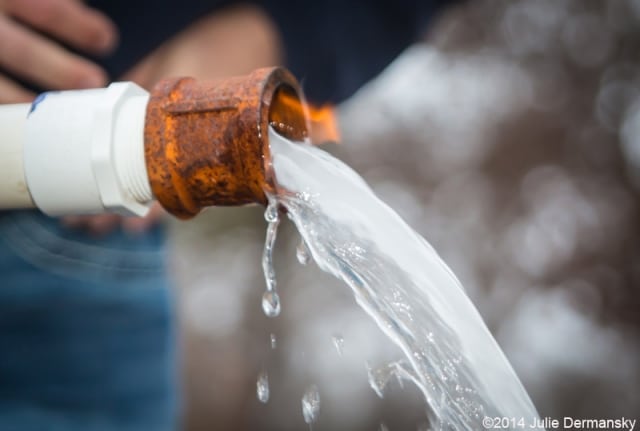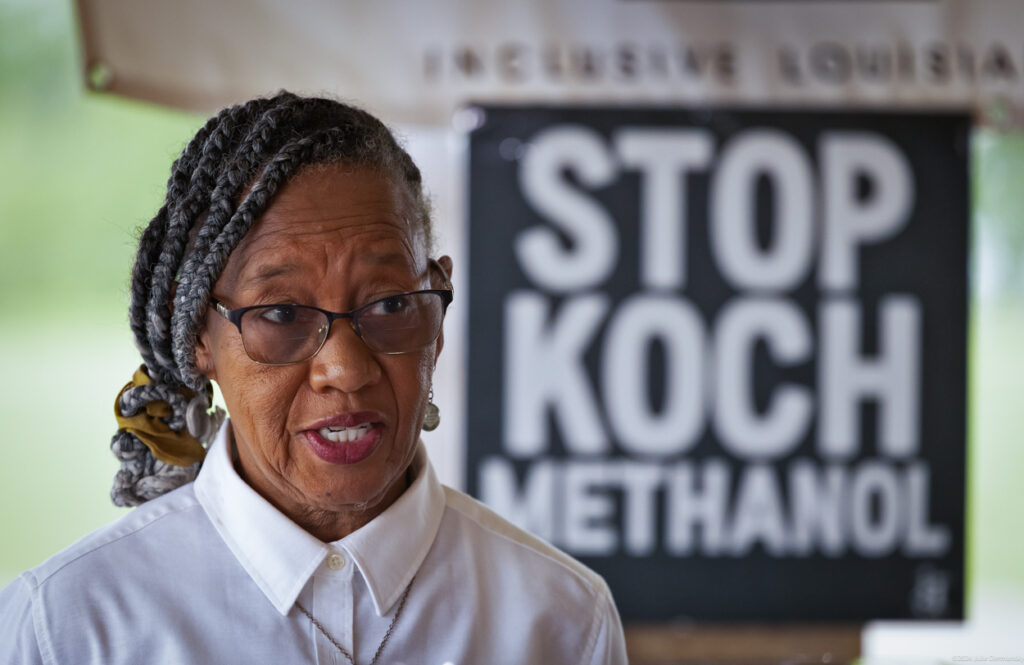At the heart of the international controversy over fracking has been the contention that the oil and gas drilling technique can contaminate people’s drinking water, sometimes even causing it to light on fire. One poster child for this claim has been Steven Lipsky, a Texas homeowner who has appeared in a viral video with a garden hose spewing flames and says his water was fouled by fracking.
For years, Mr. Lipsky has fought legal battles — most often with federal EPA investigators finding his claims of contamination credible, while Texas regulators and the drilling company, Range Resources, taking the opposite view.
An analysis released this week, describing research by scientists at the University of Texas at Arlington, may open this case once again. It offers new evidence that the tests taken at Mr. Lipsky’s well water by Range Resources and Texas regulators, who reported little or no contamination, were flawed and potentially inaccurate.
In the videotaped presentation, Zacariah Hildenbrand, a visiting scholar at the University of Texas at Arlington, lays out a detailed case that the Lipsky family’s water carries high levels of contamination, including methane matching that found in the gas from two nearby Range Resources Barnett shale gas wells, and presents evidence that past test results reported by the Texas Railroad Commission and Range were not reliable.
Much of the research he describes in the video was conducted by a team from the University of Texas at Arlington, and Dr. Hildenbrand was later hired by Mr. Lipsky’s legal team to explain those findings on tape.
Dr. Hildenbrand’s research has broad implications not just because Mr. Lipsky has become something of an icon for the anti-fracking movement. The Lipsky case was also at the center of a jurisdictional showdown between Texas and the federal government, after the EPA stepped in and issued an emergency order over the water contamination, and then Texas pushed back and the EPA dropped its investigation.
The video also further complicates Range Resource’s ongoing defamation lawsuit against Mr. Lipsky over footage showing him holding a flaming garden hose hooked to a gas vent on the well that Range Resources says misled viewers into thinking the Lipsky’s water was on fire.
“This is incredibly compelling evidence that something horribly wrong has happened here,” Dr. Hildenbrand said in the video, which Mr. Lipsky sent this summer to the EPA‘s internal watchdog, the Office of Inspector General, as part of a request that the EPA re-open his case.
Flawed Testing?
The newly released video begins with Dr. Hildenbrand describing a long list of contaminants that his research team had reported in the Lipsky’s water, including benzene, toluene, ethylbenzene and xylenes, known by the acronym BTEX. His tests showed one chemical at levels up to 60 times EPA‘s drinking water standards.
Dr. Hildenbrand’s air tests, conducted on video using the same type of equipment as Range Resources Corporation’s 2011 testing, showed methane levels built up in the air around the water in an emulated shower to levels over 150,000 parts per million (ppm) – three times the levels that EPA warns creates the risk of an explosion.
“If one were to bathe and shower in this using hot water… they will be exposed to such a high level of methane and propane that it could be dangerous,” Dr. Hildenbrand explained, adding that a person could pass out or suffocate to death.
The videotaped tests also showed propane levels of over 31,000 ppm of propane – above the EPA‘s explosion danger threshold – compared to a maximum of 19 ppm of propane when Range Resources reported its results from 2011.
“Whenever there is that much discrepancy, and we know based on other measurements that there hasn’t been significant change, you have to question those initial measurements,” Dr. Hildenbrand said. “Without a doubt.”
Dangerous Fracking Related Water Contamination: Parker County Texas from hopeforpeacenow on Vimeo.
Dr. Zacariah Hildenbrand was hired by Lipsky’s legal team to explain some of the evidence surrounding the water well contamination on video.The footage that Mr. Lipsky sent to the EPA Inspector General begins at 0:39.
Since 2011, Dr. Hildenbrand has analyzed groundwater throughout the Barnett Shale region through independent research studies funded by the University of Texas at Arlington and by the participating scientists. He is an affiliated scientist with the Collaborative Laboratories for Environmental Analysis and Remediation (CLEAR) at UT-Arlington, an industry-academia consortium focused on hydraulic fracturing, and the owner of Inform Environmental, a water testing company.
Drawing on that expertise, Dr. Hildenbrand also critiqued Range Resources’ 2011 testing, arguing that the results that Range’s investigators reported for different gasses showed signs of internal inconsistencies.
As of press time, Range Resources had not responded to a request for comment sent by DeSmog after the video was released.
There is evidence that the gas came from the Barnett shale, the rock layer that Range’s nearby fracked gas wells tapped, Dr. Hildenbrand said.
“The isotopic analysis, much like a DNA or a fingerprint, if you will, of the Barnett shale gas matches the gas that is actually coming from Mr. Lipsky’s well and that is in Mr. Lipsky’s water,” he said. “So that is conclusive evidence that you’ve got some degree of contamination coming from the Barnett shale.”
Many of the issues Dr. Hildenbrand addresses are hotly contested. Researchers from Duke and Stanford University concluded in a peer-reviewed study in 2014 that Lipsky’s well was contaminated, but that the gas came from a different formation.
“Our data are consistent with theirs, with the idea of very high methane concentrations in the old Lipsky water well,” said Professor Robert Jackson, an Earth Systems Science professor at Stanford University and one of the authors of the 2014 study. “On that we agree.”
But Prof. Jackson cautioned that many important questions remained after viewing the video. “Overall, I’d prefer to wait to see the hard evidence before concluding anything,” he told DeSmog. “[Hildenbrand] could be right, but there’s no way to tell here.”
Of course, for scientists, the gold standard is publication in peer-reviewed journals, while the video sent to EPA is a less formal summary of research findings.
Dr. Hildenbrand told DeSmog he plans to publish further analysis of contamination in the region within a year, and that data from the Lipsky wells were included in his recently published peer-reviewed study, “A Comprehensive Analysis of Groundwater Quality in the Barnett Shale Region.”
The video demonstrates striking differences between earlier reported tests and levels apparent at the Lipsky well now. Inside the Lipsky’s gas vent, Dr. Hildenbrand recorded a mixture of methane, propane, ethane and other hydrocarbons at over 860,000 ppm — in other words, a reading of more than 86 percent gas.
“And the previous measurements in this region never got above 2 or 3 parts per million,” he said. “Which again, are very curious results. They don’t make any sense.”
Don’t Mess with Texas
Dr. Hildenbrand’s research also outlines reasons to suspect that testing conducted by the Texas Railroad Commission in 2013 may have failed to accurately reflect contamination present in the water.
Dr. Hildenbrand poured glasses of tap water from the Lipsky’s kitchen sink to demonstrate the contamination, showing that the water effervesced like seltzer or champagne as methane gas bubbled to the surface.
“[A]t this concentration, the water is flammable,” he said (footage, shot in June 2015, of the Lipsky’s water on fire can be viewed at the end of the video). After switching the same kitchen tap over to a water supply which the Lipskys pay to truck in at a cost of roughly $12,000 a year, the water in the same sink ran clear.
During tests conducted by the Texas Railroad Commission, the state’s environmental regulators, in 2013 investigators also noted that some of the water effervesced. But they reported methane levels were only 8.6 ppm – below the 28 ppm threshold when water begins to bubble from the gas, Dr. Hildenbrand said.
Dr. Hildenbrand also critiqued the agency’s investigators for using a sampling method that could have allowed gasses to escape into the atmosphere, instead of a closed-loop system that would have kept the gasses trapped.
Several different rounds of testing confirmed high levels of methane in the water, he said, including tests conducted by researchers from Stanford University, the University of Texas at Austin, Duke University and his own University of Texas at Arlington team.
“We’ve never seen a value less than 50 with these [closed-loop] measurements,” he added.
The only results below safety thresholds come from Range’s 2011 testing and the 2013 tests by the Texas Railroad Commission.
“To be honest with you, the results are so strikingly different, and we know that the water quality has not changed that drastically over time, it makes you wonder about the quality of the measurements that were collected,” Dr. Hildenbrand said.
The test results reported by the Texas Railroad Commission are especially consequential.
Under Texas law, once regulators have determined that a company is not responsible for contamination, potential plaintiffs like Mr. Lipsky can be barred from filing a civil lawsuit over pollution.
The Railroad Commission is headed by three elected officials, but has repeatedly come under fire for its ties to the industry it is supposed to regulate, including campaign contributions from the oil and gas industry. “By 2010, 80% of all donations to incumbents were from industry, up from 45% in 2000,” an 2010 Public Citizen report on the Railroad Commission’s campaign financing concluded.
The Texas Railroad Commission has never concluded that fracking caused groundwater contamination.
“This case was thoroughly investigated by the Railroad Commission including the standard use of third-party experts to conduct tests,” Ramona Nye, a spokesperson for the Texas Railroad Commission, told DeSmog. She declined to answer specific questions about the water testing at the Lipsky property.
“Safe to Drink”
Battles over the Lipsky’s water have raged for half a decade. In August 2010, after his water began mysteriously fizzing and his well pump began malfunctioning, Mr. Lipsky made a series of phone calls to state regulators, asking them to investigate. That December, the EPA stepped in, issuing an emergency order over concerns that there was so much methane in the Lipsky’s well that people’s lives were endangered, sparking a turf war between Texas and the federal government.
In March 2011, the Texas Railroad Commission found that Range Resources’ nearby fracked wells were not responsible for contaminating any water wells in Parker County.
The next year, Range reached a deal with the EPA: the company would pay for water testing for the Lispkys and their neighbors and allow EPA researchers access to drilling sites as part of EPA‘s major national study of the risks fracking might posed to American drinking water supplies. EPA dropped its investigation in return.
Fracking supporters in Congress, like Senator James Inhoffe, demanded an investigation into EPA‘s intervention in the case in June 2012. But in December 2013, the Inspector General’s investigation concluded not only that EPA had been justified in intervening, but also that “the EPA lacks quality assurance information for Range Resources’ sampling program, and questions remain about the presence of contamination.”
Meanwhile, in 2011, Mr. Lipsky sued Range Resources for contaminating his water, but after the EPA abruptly dropped its investigation, his lawsuit was quickly dismissed on jurisdictional grounds — an unlawful attempt to circumvent the ruling by the Texas Railroad Commission that cleared Range Resources of liability.
Range Resources counter-sued, claiming that Mr. Lipsky, his wife, and an environmental consultant had conspired to give the company a bad name. This April, the Texas State Supreme Court dropped the conspiracy and other charges, leaving just Range’s defamation claim against Mr. Lipsky active.
In January 2011, Range Resources had conducted testing at Lipsky’s well, and found no methane or ethane and just trace amounts of propane at the well’s gas vent. That 2011 testing, as well as a series of tests conducted by the Texas Railroad Commission in 2013, provides the backbone of Range Resources’ claim that Mr. Lipsky defamed the company in a viral video showing flames spewing from a garden hose.
In a $3 million lawsuit against Mr. Lipsky, his wife, and an environmental consultant, Range Resources alleged that the three had defamed the company and conspired to damage its reputation. They say Mr. Lipsky’s water was not in fact on fire in the video, and that instead he had fabricated evidence that his water was flammable by connecting a garden hose to the water well’s gas vent, making it look like water was burning when in fact there wasn’t any water in the hose.
Based on its 2011 test results, Range Resources sent the Lipskys a February 2011 letter telling them that their water was fine. Although Range found high levels of methane at or before the gas vent, once the water passed the vent, their testing showed only trace amounts of gas or none at all.
“The results show that your water is safe to drink and there is no danger in using the water in your home,” Range Resources wrote in a February 2, 2011 letter reporting its testing results.
EPA Asked to Re-Investigate
EPA’s December 2011 emergency order was denounced by Texas state officials as a federal intrusion into a state problem. “This is Washington politics of the worst kind,” Railroad Commission member Michael Williams told the Dallas Observer at the time.
Shortly thereafter, in March 2012, the EPA dropped its investigation into the Lipsky’s water under a non-binding agreement that required Range Resources to test Mr. Lipsky’s two water wells and many others nearby and to cooperate with the EPA’s national study into the risks that fracking poses to American drinking water supplies.
But by the next month, a confidential EPA document obtained by DeSmog, shows that Range Resources had already extracted a series of concessions by the EPA — and in the end, the EPA never conducted the study that Range had agreed to.
The EPA’s draft assessment on fracking and drinking water risks, released in June of this year, found multiple cases of water contamination — but the accompanying press release said that “hydraulic fracturing activities have not led to widespread, systemic impacts to drinking water resources.”
Days after EPA’s draft assessment was released, a peer-reviewed study authored by Dr. Hildenbrand, reported high levels of pollutants in many tests of 550 water wells in the Barnett shale region, including the Lipsky well.
If the test results from Lipsky’s wells and other nearby water wells provided by Range Resources to the EPA were flawed, as Dr. Hildenbrand argues, that could mean that the EPA abandoned its investigation and in return the agency obtained only promises from Range that were never properly fulfilled.
Mr. Lipsky has asked the EPA to resume its investigation.
That request is still pending. “The OIG has no ongoing work related to the alleged contamination of Mr. Lipsky’s well,” a spokesperson for the Office of Inspector General said. “We referred a recent complaint to EPA Region 6 for action.”
EPA Region 6, which covers Texas, told DeSmog that the the request was under consideration. “We are reviewing the information which is very similar to our previous investigation to determine if additional steps are needed,” spokesman David Gray said.
Photo Credit: Steven Lipsky lights his water on fire. ©2014 Julie Dermansky
Subscribe to our newsletter
Stay up to date with DeSmog news and alerts






